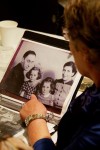As a young woman, Sophie Zeidman Hamburger had faced death before the German Nazi soldiers at Auschwitz-Birkenau concentration camp. At the age of 93, she told her story to a group of eager students in the main room of Hillel at UCLA. Andrew Rosenstein, a young Jewish man who had never known the horrors of the Holocaust, sat in front of her, intent on listening to her experience.
From the time of his introduction to Hamburger in 2012, UCLA alumnus Rosenstein has endeavored to give a voice to the stories of Holocaust survivors. Along with fellow UCLA alumnus Fawad Assadullah, Rosenstein began work on a feature length documentary, “Light out of Darkness,” to spread the survivors’ stories to a larger audience. On Wednesday, the film creators will premiere their documentary to an open audience including Holocaust survivors in Royce Hall.
Rosenstein first became involved with the Holocaust survivors as part of a German 118 course taught by professor Todd Presner, who introduced students to the Center for Jewish Study’s Bearing Witness Program. The program connected students with Holocaust survivors and allowed them to listen to their stories. Presner has since worked closely with Rosenstein in creating the film by looking at various versions of the documentary leading up to the showing.
“I think that he captured the tenderness, the relationships, the love, the families, the lives that they built,” Presner said. “The film does this really quite beautifully.”
During his third year at UCLA in 2013, Rosenstein heard the news of Hamburger’s death, spurring him to create the film.
“It was complicated because there were so many survivors who are still in the program that I really wanted to have their stories documented as well,” Rosenstein said. “I thought that as long as I was in film school that it was the right time to tell the stories of the other survivors in the program.”
Rosenstein and fellow film student Assadullah interviewed 17 Holocaust survivors as the focus of the film.
Rosenstein said the survivors were very enthusiastic about sharing their stories and even invited them into their own homes to conduct the interviews. From the cushions of their living room couches, the Holocaust survivors told their stories as Rosenstein and Assadullah listened intently and recorded every word.
The pair put together the first cut of the film after the interviews, creating footage that would grow into their feature length documentary. Less than a year later, UCLA alumnus Jay Weneta joined the team and began editing with Rosenstein and Assadullah to design a more cinematic piece to reach the widest audience possible.
Despite their limited resources, Weneta said they focused on intercutting the interviews with stock cinematic shorts, helping viewers to visualize the survivors’ stories and creating an emotional connection between the past and the present day. After the screening, the filmmakers have plans to replace the stock footage with original shorts by taking shots of different actions like letter-writing or water falling to accompany survivor’s stories, Weneta said.
By using a more cinematic telling of the Holocaust survivors’ stories, the filmmakers are also trying to step away from past Holocaust documentaries by focusing on the survivors’ lives after the Holocaust in conjunction with their historical experiences.
“This isn’t old history,” Weneta said. “With the stories, we don’t want to exclusively define them as a series of Holocaust survivors; it’s more here’s how they’ve all gone on to live good lives.”
Despite the cinematic additions, Rosenstein said he and his fellow filmmakers are first and foremost spotlighting the voices of the Holocaust survivors, which will remain the focal point of the documentary.
“I think it’s important to share the emotional aspects of life through filmmaking,” Rosenstein said. “Often in life we search for the truth of the past but what’s not always clear is the emotional truth of what happened.”
